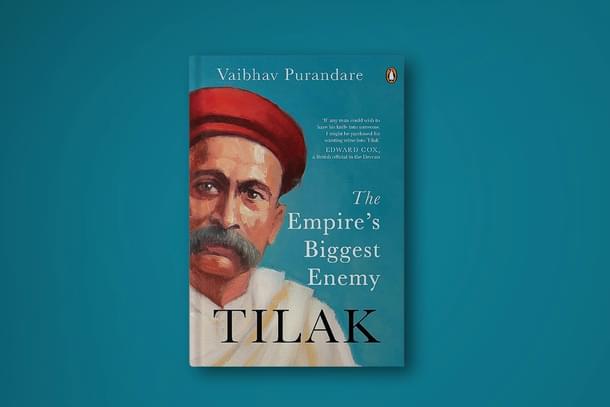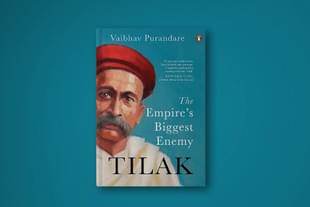Books
Unifying Hindus — How Tilak Mobilised Maharashtra To Honour Shivaji’s Legacy
Vaibhav Purandare
Aug 01, 2024, 09:59 AM | Updated 11:00 AM IST
Save & read from anywhere!
Bookmark stories for easy access on any device or the Swarajya app.


Tilak: The Empire's Biggest Enemy. Vaibhav Purandare. Penguin (Vintage Books). Pages 480. Rs 650.
Mahadev Govind Ranade called a public meeting in Poona of sardars and influential citizens to take up the cause of the Shivaji memorial, and the Bombay government led by Lord Reay in April 1885 made an annual grant of five rupees for maintenance of the samadhi.
Around this time, biographies of the Chhatrapati and plays on his life began to be produced in the Marathi-speaking regions. Ranade himself wrote a series of articles on the Maratha power in 1893, and the following year, the scholar R.P. Karkaria gave a lecture on the Shivaji versus Afzal Khan episode at the Royal Asiatic Society of Bombay and spoke of how Shivaji was fully justified in killing the Bijapur general.
The lecture created a mini sensation, spurring further interest, and early in 1895, the Native Opinion reiterated Douglas’s complaint about the state of Shivaji’s samadhi.
Taking the cue, Tilak stepped forward to champion the cause of the memorial. Quite provocatively, he said,
‘It is useless to blame the government for neglecting the shrine. It is the business of the people of Maharashtra to take the opportunity to vindicate the name of Shivaji. It would be highly creditable to those generous and grateful descendants of the Maharaja who opened their purses for contributing to the fund of the insignificant Lord Harris, if they renovated the shrine of Shivaji.’
Harris had just retired as governor that year, and in calling him ‘insignificant’, Tilak was attacking him as well as asking Shivaji’s descendants to step up. In another piece, he asked, ‘Should we not hang our heads in shame that a foreigner should tell us about our duty to Shivaji?'
Tilak proposed that a fund be set up to repair and restore Shivaji’s memorial and began to publish in Kesari the names of contributors, however small the amounts they came up with. ‘Every pai (one-third of a penny) would be acknowledged in the Kesari,’ Tilak made plain.
A student with no source of income sent in two annas, and Tilak praised him in the Kesari of 30 April 1895 for his ‘spirit to work for Swarajya (self-rule, the idea embodied by Shivaji)’. Other papers in Poona too picked up the campaign, and it gained enough momentum in a couple of months for Tilak to organize a meeting, jointly with Senapati Dabhade of Talegaon, at the Hira Baug in Poona on 30 May 1895.
A number of princes and local chieftains attended, and it was resolved to raise a fund for repairing the samadhi, build a chhatri or umbrella on it and to set up a committee to oversee this task, with Tilak as its working secretary. ‘One of the resolutions was seconded by a Muslim.’ Among the members of the committee were not only Tilak’s followers such as Khasgiwale and Balasaheb Natu but three chiefs (one of Ichalkaranji near Kolhapur and two from Kurundwadi), some sardars, G.K. Gokhale of the Ranade group and Gangaram Bhau Mhaske, a big Maratha promoter of the education of non-Brahmans.
This was an achievement in itself. People across social groups were involved from the beginning, taking Tilak’s success beyond that of the Ganapati festival. So impressed was the pro-reform Sudharak that its correspondent reported that ‘never in the history of Poona was there
ever seen, since the advent of British rule, the like of the Hira Baug
meeting.’
More and more people were being mobilized for what would eventually be political action in the cause of national freedom. The Indu Prakash exulted that ‘no surer sign of raising the national spirit can be seen.’ By November that year, the fund had gathered Rs 11,000, with the single biggest contribution of Rs 1000 coming from the Maratha ruler of Baroda, Sayajirao Gaekwad.
To give things a more institutional character, Tilak launched the annual celebration of the Shivaji festival on the Chhatrapati’s birth anniversary in 1896. With a significant bunch of followers, Tilak reached the base of the Raigad fort the evening before the celebrations, which were due on 15 April. He had already appealed to the locals of Mahad, the area in which the fort stands, to make the event big, and many of them had joined in.
Everyone expected to climb up early the next morning. But Tilak, after his evening meal, said he’d go straight away. Those around him decided to go along. Immediately, a number of flaming torches were organized, mostly by the locals of Mahad, and a biggish group began its ascent. The pathway wasn’t easy; Raigad had been neglected for long, and in some places, the passes were narrow. Yet scores of people moved up in a single file in the dark, with individuals carrying torches placed between every four or five persons.
Shivram Mahadev Paranjpe, an evocative chronicler, editor of the Kaal and a keen follower of Tilak, wrote that it brought up in everyone’s mind a picture of how Chhatrapati Shivaji must have climbed the fort in the seventeenth century with his loyal Mavale (soldiers). The spirit got into them all, and there were cries of ‘Shivaji Maharaj Ki Jai’ and ‘Tilak
Maharaj Ki Jai’.
For a very, very long time after this, and in fact even after he had obtained the title of ‘Lokmanya’, Tilak during his lifetime was commonly referred to as ‘Tilak Maharaj’ by those who saw him as their hero.
The ‘spirit’ was exactly Tilak’s idea. He said his notion wasn’t that people should imitate exactly what Shivaji had done in the seventeenth century. Those were different times. But it was the spirit Shivaji Maharaj had fostered that needed imbibing, he said.
Most importantly, ‘if there was a single iconic figure who had the love, affection and respect of all castes and all social groups in Maharashtra, it was Chhatrapati Shivaji. So, to maintain differences such as “Brahmans and Marathas” and “Brahmans and Prabhus” in the festival would be absolutely wrong’. Shivaji had given the people a national identity, he stressed, and it was this identity that must be focused on.
In later editions of the festival, he pointed out Shivaji was not anti-Muslim and had never insulted the Islamic faith but had fought against Mughal rule and against Aurangzeb for the protection of his faith and society.
Vaibhav Purandare is a senior editor at The Times of India, and author of the critically acclaimed; ‘Sachin Tendulkar: A Definitive Biography’ and ‘Bal Thackeray & the Rise of the Shiv Sena’.





